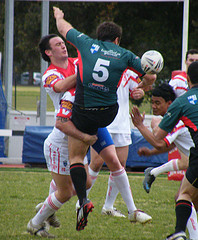If you are a sports physiotherapist that works with triathletes then you are all too aware of the potential for the development of overuse injuries. The triathlon is a grueling sport with distances ranging from Sprint distance (750 m swim, 20 km bike, 5 km run) through to the Ultra Distance or Ironman Triathlon distances (750 m swim, 20 km bike, 5 km run). No wonder many triathletes suffer overuse pathologies huh? This article discusses new research into the potential role of plyometric training in the injury prevention and rehabilitation of triathletes…
In this episode of the podcast I interview Rod Whiteley. Dr Rod Whiteley (FACP) is a Specialist Sports Physiotherapist, and has extensive experience working with elite sportsand has consulted with the Australian Baseball Federation and the Australian Institute of Sport. He is widely published in peer review journals on the topic of the throwing shoulder.

If you are a sports physiotherapist that manages athletes that compete in contact sports, then I am sure that you have treated contact or collision related injuries. Now sports physiotherapists who work with rugby league will take specific note and interest with this research. Do not despair if you do not work with rugby league, you may have experience working with similar contact sports such as rugby union. This post discusses new research on physical collisions in professional rugby league, their impact on injuries and the sports physiotherapy implications.
Introduction Sports physiotherapists will regularly (I’m talking every day) rehabilitate knees that have undergone ACL reconstruction. As the vast majority of you will know, it is a common injury with a relatively long rehabilitation timeframe (generally 6 – 12 months depending on surgeon’s preference). This long rehabilitation and progression through to return to play (RTP) […]

Today we are mixing it up. We are going to do something a little bit different. Today is a guest post from Richard Evans, who is the Head Physiotherapist from Right to Dream (discussed below). We have had a few contacts with Rich, and he was keen to get involved with contributing some content to the site. So from this month, Rich will be contributing to the site by adding some of his own clinical tips and posting interesting case studies for discussion amongst the community here at TheSportsPhysiotherapist.com. I thought that he was in such a unique and interesting situation I could not say no. He has got some great things to talk about from a unique perspective, so enjoy (over to you Rich)…

What if I were to tell you that I was going to discuss the second most common foot injury in athletes, that is missed or misdiagnosed in 1 in every 5 cases? Is that something you might be interested in? Well that is what happening… Lisfranc joint injuries are a challenging presentation in an athletic population. As stated above, they are relatively common and regularly misdiagnosed. However, unfortunately they have the potential to develop into a CAREER-ENDING injury! Undoubtedly, this makes prompt and accurate diagnosis and evidence based management exceptionally important.
As a sports physiotherapist I am frequently asked by my athletes do I know about the latest in dietary, workout or “get huge/play like superman” supplement. What is in it, what does it do, and how much can I take before an alien busts out of my chest? Firstly, I make the statement that I am not an expert dietitian or nutrionist (not even close). Additionally, these new different supplements seem to come out so fast it is exceptionally challenging to keep up with either the “proposed” or “proven” mechanisms of action. So what should we do…?




